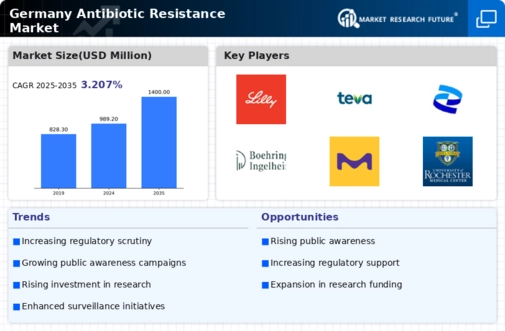The Germany Antibiotic Resistance Market is witnessing significant developments driven by an increasing awareness of the consequences of antibiotic misuse and the emergence of resistant bacteria. Various stakeholders, including pharmaceutical companies, healthcare professionals, and regulatory bodies, are focusing on innovative strategies to combat antibiotic resistance. The market dynamics are influenced by the growing prevalence of chronic diseases, a rise in healthcare costs associated with treating resistant infections, and heightened regulatory scrutiny regarding antibiotic prescriptions.
Competitive forces in this space are characterized by a mix of established pharmaceutical companies and emerging biotechnological firms, all vying to develop effective solutions against antibiotic resistance. Consequently, the landscape is marked by collaborations, partnerships, and a concerted push toward research and development of new antibiotics and alternative therapies.Eli Lilly has established a strong presence in the Germany Antibiotic Resistance Market, tapping into its robust research and development capabilities. The company boasts a comprehensive portfolio that emphasizes innovative therapeutic solutions aimed at addressing the challenges posed by antibiotic resistance.
Eli Lilly is well-regarded for its advanced scientific expertise, allowing it to engage in collaborations with academic institutions and healthcare providers focused on studying antibiotic resistance patterns in Germany.
This strategic positioning not only enhances its visibility within the market but also underscores its commitment to tackling worsening healthcare challenges. Eli Lilly's strengths lie in its ability to conduct cutting-edge research along with a solid pipeline of antibiotic candidates designed to combat resistant pathogens effectively.Teva Pharmaceuticals has made significant strides in the Germany Antibiotic Resistance Market with a diverse array of antibiotic products designed to address the needs arising from antibiotic resistance. The company's commitment to affordability and accessibility has positioned it favorably in Germany's healthcare landscape.
Teva Pharmaceuticals emphasizes the development of generics, which play a crucial role in ensuring that healthcare providers have access to cost-effective treatment options for resistant infections.
Additionally, Teva engages in strategic mergers and acquisitions to bolster its market presence and expand its product offerings. Through these efforts, the company aims to enhance its capabilities in addressing the urgent need for new therapeutic alternatives. By maintaining a collaborative approach with healthcare providers and leveraging its strong distribution network, Teva Pharmaceuticals continues to reinforce its market strength while contributing to the broader fight against antibiotic resistance in Germany.























